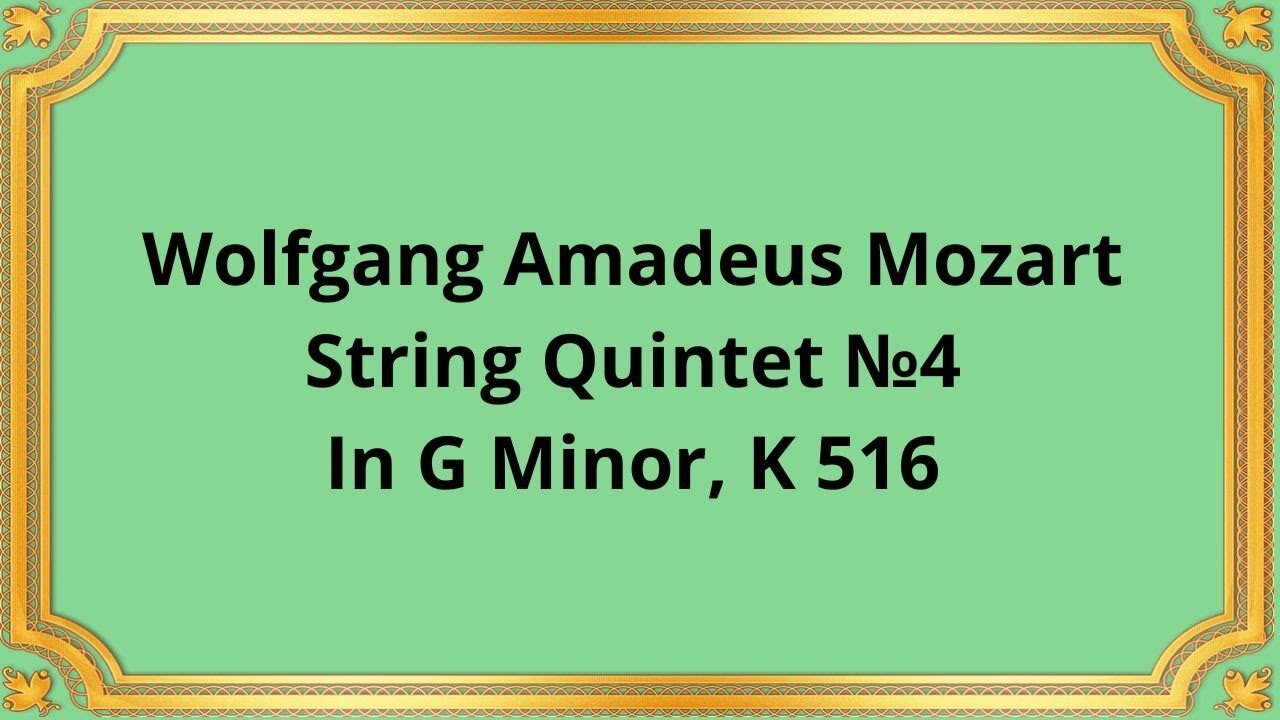Premium Only Content

Wolfgang Amadeus Mozart String Quintet №4 In G Minor, K 516
#Mozart #ClassicalMusic #StringQuintet #MusicalComposition #GMinor #K516 #ChamberMusic #MusicHistory #MusicAppreciation #18thCenturyMusic #Vienna #ClassicalComposers #MusicGenius #Ensemble #StringEnsemble #Quintet #InstrumentalMusic
Publication date 1951
THE GRILLER STRING QUARTET
MAX GILBERT, Viola
S. Griller & J. O’Brien, Violins
P. Burton, Viola
B. Hampton, Cello
Wolfgang Amadeus Mozart, a prodigious composer of the Classical era, left an indelible mark on the world of music with his exceptional body of work. Among his vast repertoire, the String Quintet No. 4 in G Minor, K 516 stands as a testament to Mozart's compositional genius.
Composed in 1787, during Mozart's prolific years in Vienna, the String Quintet No. 4 in G Minor, K 516 showcases the composer's mastery in chamber music. This period marked a turning point in Mozart's career, where he sought to push the boundaries of musical expression, experimenting with innovative forms and harmonic complexity.
The String Quintet No. 4 is written for two violins, two violas, and a cello, a unique configuration that allows for rich harmonic textures and expressive possibilities. Comprising four movements, the quintet adheres to the traditional structure of Classical chamber music:
1. Allegro: The opening movement bursts forth with dramatic intensity, characterized by its driving rhythms, intricate counterpoint, and interwoven melodies. This movement showcases Mozart's ability to seamlessly transition between moments of turbulence and delicate lyricism.
2. Menuetto: The second movement, a graceful minuet and trio, provides a contrast to the preceding Allegro. Its elegant melodies and charming dance-like qualities create a sense of refined elegance, demonstrating Mozart's keen sense of balance and musicality.
3. Adagio: The third movement, an Adagio in E-flat major, transports the listener to a realm of introspection and heartfelt emotion. With its lush harmonies and tender melodies, this movement showcases Mozart's ability to evoke deep emotional resonance.
4. Adagio-Allegro: The final movement returns to the minor key, exuding a sense of urgency and restless energy. Mozart employs virtuosic passages, rapid scale runs, and contrapuntal interplay to create a thrilling and energetic conclusion to the quintet.
Mozart's String Quintet No. 4 in G Minor, K 516 is a testament to his compositional brilliance and his ability to create profound musical experiences. Through its captivating melodies, intricate harmonies, and skillful interplay between the instruments, this quintet offers a glimpse into Mozart's genius and his ability to convey a range of emotions.
The work's innovative harmonic language, expressive depth, and structural intricacy set it apart from its contemporaries, solidifying its place as one of Mozart's most revered chamber music compositions. The String Quintet No. 4 in G Minor, K 516 showcases Mozart's ability to balance passion and technical prowess, making it a cornerstone of the chamber music repertoire.
Conclusion:
Wolfgang Amadeus Mozart's String Quintet No. 4 in G Minor, K 516 stands as a testament to his exceptional talent and enduring musical legacy. Through its remarkable structure, expressive depth, and innovative harmonies, this quintet continues to captivate audiences and inspire musicians to this day. Mozart's ability to blend technical mastery with emotional depth is aptly showcased in this quintet, cementing its status as a masterpiece of the chamber music genre and a testament to Mozart's brilliance as a composer.
You have the opportunity to support the channel:
https://destream.net/live/RadSiarAl/donate
https://www.buymeacoffee.com/6355radsiaral
-
 4:15:57
4:15:57
Joker Effect
12 hours agoJoker plays... S.T.A.L.K.E.R.2: Heart of Chornobyl
119K42 -
 32:56
32:56
MYLUNCHBREAK CHANNEL PAGE
18 hours agoUnder The Necropolis - Pt 3
84.1K56 -
 37:08
37:08
Degenerate Plays
22 hours ago $5.70 earnedThe Greatest Chase Scene Of All Time - Assassin's Creed : Part 33
41.5K3 -
 1:08:34
1:08:34
Squaring The Circle, A Randall Carlson Podcast
22 hours ago#034 The Mysteries Of Stonehenge: Uncovering The Origins Of The Stones - Squaring The Circle
28.5K9 -
 10:35
10:35
Misha Petrov
18 hours ago"We Need More Women Firefighters!" LA Wildfires Expose Shocking Mismanagement and DEI Priorities
34.3K75 -
 8:36
8:36
Gamers Unbeaten
23 hours agoMarvel Rivals: The Menace of Jeff the Shark | Deep Thoughts While Gaming
89.8K8 -
 11:05
11:05
Guns & Gadgets 2nd Amendment News
18 hours agoBREAKING NEWS: ATF Reinstituting The Pistol Brace Ban?!
60.8K26 -
 48:04
48:04
PMG
20 hours ago $12.19 earned"Will Trump FINALLY Prosecute the 2020 Election Criminals? w/ FEC Commissioner Trey Trainor"
44.8K7 -
 11:19:20
11:19:20
Phyxicx
19 hours agoFinal Fantasy XIV - Finishing Stormblood - 1/11/2025
105K5 -
 9:21
9:21
BlackDiamondGunsandGear
19 hours agoBest of Both AR-15 + Ak47 = CMMG Mutant DISSENT
73.9K9